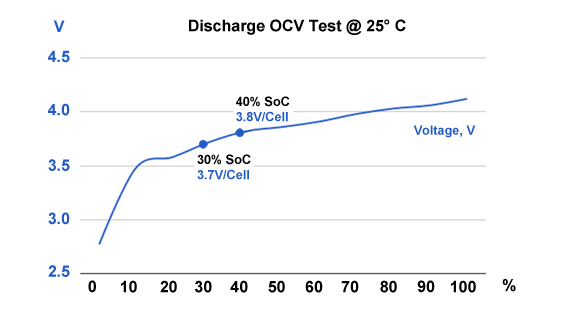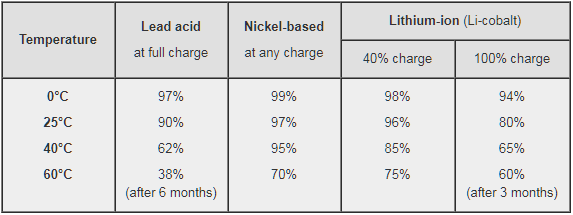Learn about storage temperatures and state-of-charge conditions
The recommended storage temperature for most batteries is 15°C (59°F); the extreme allowable temperature is –40°C to 50°C (–40°C to 122°F) for most chemistries.
Lead acid
You can store a sealed lead acid battery for up to 2 years. Since all batteries gradually self-discharge over time, it is important to check the voltage and/or specific gravity, and then apply a charge when the battery falls to 70 percent state-of-charge, which reflects 2.07V/cell open circuit or 12.42V for a 12V pack. (The specific gravity at 70 percent charge is roughly 1.218.) Lead acid batteries may have different readings, and it is best to check the manufacturer’s instruction manual. Some battery manufacturer may further let a lead acid to drop to 60 percent before recharge..)
Low charge induces sulfation, an oxidation layer on the negative plate that inhibits current flow. Topping charge and/or cycling may restore some of the capacity losses in the early stages of sulfation.
Alkaline
Alkaline and other primary batteries are easy to store. For best results, keep the cells at cool room temperature and at a relative humidity of about 50 percent. Do not freeze alkaline cells, or any battery, as this may change the molecular structure. Some lithium-based primary batteries need special care
Lithium-based
There is virtually no self-discharge below about 4.0V at 20C (68F); storing at 3.7V yields amazing longevity for most Li-ion systems. Finding the exact 40–50 percent SoC level to store Li-ion is not that important. At 40 percent charge, most Li-ion has an OCV of 3.82V/cell at room temperature. To get the correct reading after a charge or discharge, rest the battery for 90 minutes before taking the reading. If this is not practical, overshoot the discharge voltage by 50mV or go 50mV higher on charge. This means discharging to 3.77V/cell or charging to 3.87V/cell at a C-rate of 1C or less. The rubber band effect will settle the voltage at roughly 3.82V. Figure 1 shows the typical discharge voltage of a Li-ion battery.

Capacity Loss during Storage
Storage induces two forms of losses: Self-discharge that can be refilled with charging before use, and non-recoverable losses that permanently lower the capacity. Table 2 illustrates the remaining capacities of lithium- and nickel-based batteries after one year of storage at various temperatures. Li-ion has higher losses if stored fully charged rather than at a SoC of 40 percent.
Batteries are often exposed to unfavorable temperatures, and leaving a mobile phone or camera on the dashboard of a car or in the hot sun are such examples. Laptops get warm when in use and this increases the battery temperature. Sitting at full charge while plugged into the mains shortens battery life. Elevated temperature also stresses lead- and nickel-based batteries

Fello Tech Co., Ltd established in 2005, is specialized in the research and manufacturer of lithium polymer battery, li-ion battery, LiFePO4 battery and primary lithium batteries. It occupies more than 30000 squares feet of floor space and employs more than 1000 skillful workers in production team with more than 40 experienced engineers and technician and becomes one of the most innovative lithium batteries manufacturer in the industry.
You can contact us any way that is convenient for you. We are available 24/7 via !
If you need any lithium battery or battery packs, please send us your detailed information about the voltage, the capacity and the size.
 online service
online service 86 755 89351622
86 755 89351622 sales@fellotech.com
sales@fellotech.com lucyjiang123
lucyjiang123 +8613691821586
+8613691821586